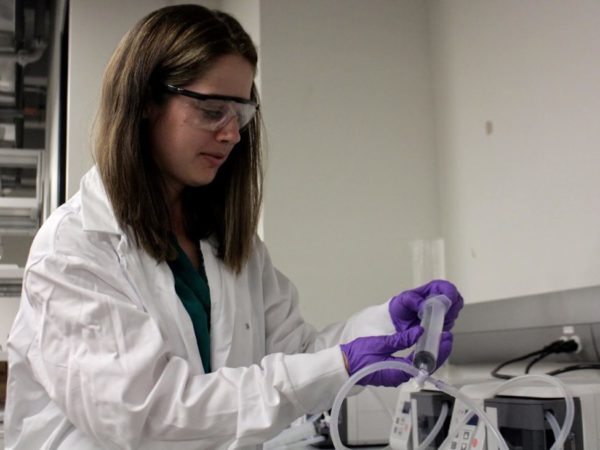
By Meghan Rutigliano
This article was republished here with permission from Planet Detroit.
This story is from Planet Detroit’s Neighborhood Reporting Lab, where community reporters write about health and climate issues in their neighborhood. Neighborhood Reporting Lab is supported by the Americana and Kresge Foundations.
When I moved to Detroit, the sleek lines of Mies Van der Rohe’s Lafayette Park, along with its proximity to the Dequindre Cut, Eastern Market and the Detroit River, drew me in. But as I settled into my new apartment, I encountered an ironic twist: pristine architecture paired with not-so-pristine drinking water.
My journey into the depths of domestic water quality began innocuously, with a friend’s offhand comment about the peculiar taste of my water. This sip of concern led me down a river of discovery about what flows from my faucets and how other Detroiters can navigate similar currents.
Read on for a low-cost, DIY solution that will have your tap water looking and tasting better almost instantly and the self-discovery that led me to want more for renters in the City of Detroit.
DIY drinking water quality tests: Observations at the tap
Could my Lafayette Park apartment, a bastion of Bauhaus modernism, have dubious innards that didn’t match its polished exterior?
To demystify my building’s plumbing, I consulted Elin Warn Betanzo, a water quality expert integral to revealing the Flint water crisis. She suggested a simple, cost-effective test to evaluate the murkiness in my tap water.
First on Betanzo’s mind: Could my drinking water contain lead?
“Most of our plumbing does contain some lead,” Betanzo warned, laying the groundwork for my investigative journey.
She advised, “Start simple: observe, taste and photograph your water. Let it sit and see if the cloudiness dissipates or if particles settle.”
Using clear cups for visibility, I documented the cloudiness with large, lingering bubbles and floating particulates, capturing evidence for both my landlord and Betanzo.
An aerator enlightenment
Betanzo nudged me toward a revelation at my kitchen sink—the aerator. This modest screen, fitting snugly on the faucet’s end, conserves water and traps harmful particles like lead.
“If particulate matter is getting pushed around the water pipes, it can get trapped in the aerator’s screen,” she said. A closer inspection of my faucet revealed a missing aerator, so contaminants faced no obstacle to getting into my glass.
Prompt installation by my landlord’s maintenance team, a process that took less than 30 seconds, provided an immediate and stark improvement to my water’s quality.
After the aerator was installed, my water looked more clear. The cloudiness disappeared after just a few minutes, and I detected no floating particles.
It turns out that this unsung hero mixes air into the water flow and traps harmful particulates like lead. Costing only $5 to $15, and installable quicker than you can boil a pot of water, it’s a no-brainer and something any Detroit tenant should request from their landlord. And, if they don’t respond, you can purchase one at a hardware store. I’ve now installed an aerator in my bathroom, too.
Betanzo warned me that it’s crucial for me to clean the aerators monthly, especially for buildings with older plumbing like mine. This is critical to make sure the aerator is improving the water quality — and not making it worse.
Diving deeper into drinking water drama
Was the aerator a magic bullet? Almost.
Post-installation, the water’s clarity improved dramatically, reassuring me of its safety. Yet, as Betanzo cautioned, clear water could still harbor invisible threats like lead.
She elaborated on the pipe materials likely in my building: “It’s probably a combination of galvanized steel, copper plumbing and, where there have been recent repairs, likely some plastic plumbing as well.”
She also told me that valves, fixtures and faucets usually have brass in them, which can lead to high lead content.
The city estimates there are more than 80,000 lead pipes delivering drinking water to Detroit residents. Single-family homes built before 1945 are most likely to be affected. The Detroit Water and Sewage Department is actively working to replace them.
But attempting to navigate DWSD’s drinking water testing protocol was another saga. While installing an aerator fixed the problem from a taste and visual perspective, I still wanted to obtain a water test from the city.
Armed with only a vague confirmation from my building’s maintenance staff that my pipes were non-lead, I faced bureaucratic hurdles that seemed insurmountable for apartment dwellers like me.
To qualify for a free city-provided test, a resident must demonstrate lead-based plumbing—impossible without deeper knowledge or access to the building’s infrastructure.
The process was daunting, fraught with requests for details like meter readings and pipe materials.
“The system isn’t built with apartment dwellers in mind,” Betanzo said, pinpointing a systemic oversight that leaves renters particularly exposed to potential water issues and without direct support from DWSD.
The sampling protocol is based on state and federal requirements—and these protocols are biased toward single-family residences.” Because I couldn’t prove that I had lead pipes, and without direct access to the water meter readings DWSD asks for on their water test request form, I couldn’t request a test directly from the city.
Still seeking clarity
Though the aerator mitigated my immediate concerns, questions about water safety linger. Greater advocacy for accessible testing and broader education about drinking water management in Detroit remains necessary.
As I begin to advocate for transparency and safety in urban drinking water systems, I encourage my fellow Detroiters to twist on that aerator, fill up your glass, and make sure your water is as clean, clear, and tasty as it can be.
In a city celebrated for its resilience, ensuring safe, clean water for all should be a shared priority.
This story isn’t just about one renter’s journey toward crystal-clear water. It’s a call to action for all Detroiters to understand the fluids that fuel us—literally. It’s an invitation to become more aqua-savvy, ask probing questions about what lurks in our pipes and insist on transparency and high standards from those who manage our water resources.
Resources:
Request a Lead Test from DWSD here, or order an at-home test kit. Learn more about Detroit drinking water here and about lead in plumbing here.
Catch more news at Great Lakes Now:
Composting, water access and backyard chickens: Detroit’s urban farming evolution
Featured image: As an apartment-dweller, getting answers about my Detroit drinking water was not simple. Photo by Meghan Rutigliano.




